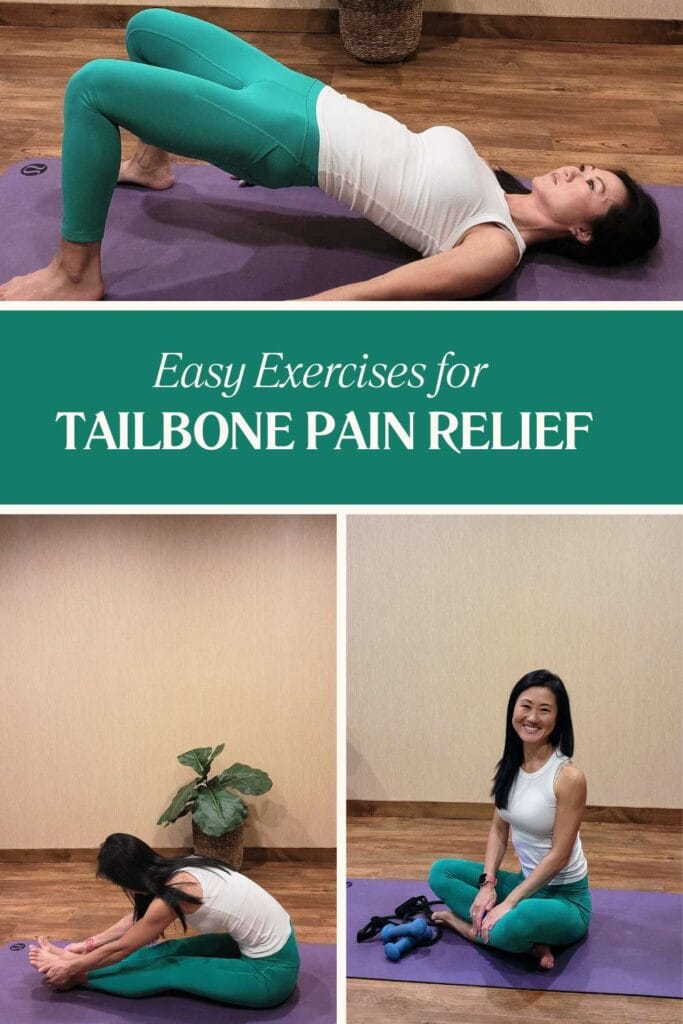Tailbone Pain Relief: Natural Remedies for a Quick Recovery
Last Updated on February 5, 2025 by Dr. Tiffany Egan
Tailbone pain, or coccydynia, can be quite debilitating! It often is a result of various causes, such as injury, prolonged sitting, or even childbirth. I’ve experienced this discomfort firsthand, and understanding the reasons behind it can be the first step toward effective tailbone pain relief.
Understanding Tailbone Pain: Causes and Symptoms
Common symptoms include a sharp or aching sensation near the bottom of the spine, especially when sitting or standing for long periods. You might notice that certain movements, like bending or lifting, exacerbate the pain. In some cases, I’ve found that even clothing can irritate the area, adding to the discomfort.
Identifying the specific cause of your tailbone pain is crucial. It could be due to trauma from falls, repetitive stress, or even an infection. By recognizing these symptoms in myself, I was better equipped to seek the right remedies and treatments.
The Importance of Proper Diagnosis for Tailbone Pain
Before diving into remedies, it’s vital to ensure an accurate diagnosis. Fortunately, because I am a chiropractor myself, I knew what my body was telling me. But many people learn this the hard way when they try various treatments without understanding the underlying cause of their discomfort.
Consulting with a healthcare professional such as a physical therapist or chiropractor can help pinpoint the issue, whether it’s a fracture, inflammation, or a simple case of muscle strain.
During a visit to a healthcare professional, they might conduct physical examinations and imaging tests, such as X-rays, to rule out serious conditions. This step is essential because it guides the treatment process. Remember that not all tailbone pain is the same, and personalized care is key!
Once you have a diagnosis, it empowers you to explore appropriate treatments. This knowledge not only aids in the healing process but also prevents future issues. It’s best to understand this sooner than later, as it could save you a lot of time and discomfort.

Natural Remedies for Quick Tailbone Pain Relief
When seeking tailbone pain relief, there are several natural remedies that prove to be effective. One of my favorites is applying heat or ice to the affected area. Ice packs can help reduce inflammation, while heat can relax tight muscles. I found alternating between the two worked wonders for most people.
Another remedy I explored is herbal supplements. Turmeric and ginger, known for their anti-inflammatory properties, became staples in my diet. I often brewed turmeric tea or added ginger to my meals. These Turmeric and Ginger Wellness Shots not only aided my recovery but also contributed to my overall well-being.
Additionally, I discovered the benefits of using a cushion or pillow designed specifically for tailbone pain. These cushions can alleviate pressure while sitting, providing me with the comfort I needed during long periods of inactivity. Incorporating these natural remedies into my routine made a significant difference in my healing journey.
Effective Stretches to Alleviate Tailbone Discomfort
In my quest for relief, I found that incorporating effective tailbone stretches was a game-changer. One stretch I particularly enjoyed was the seated forward bend. Sitting on the padded or carpeted floor with legs extended, I would gently lean forward, feeling a nice stretch along my back and tailbone. This helped me ease tension and improve flexibility.
Another stretch that worked wonders was the pelvic tilt. Lying on my back with my knees bent, I would tighten my abdominal muscles and tilt my pelvis upward. This simple move not only strengthened my core but also provided a gentle stretch to the tailbone area. I made it a point to perform these stretches daily.
Lastly, the child’s pose became a go-to for me. These yoga poses allowed me to relax my lower back and tailbone while feeling a sense of calm. I found that holding this pose for a minute or two helped alleviate discomfort significantly. Incorporating these stretches into my routine brought about noticeable relief and improved my overall mobility.
Essential Exercises for Strengthening the Tailbone Area
In addition to stretches, I learned the importance of tailbone pain exercises to help strengthen the muscles around my tailbone. One of the most effective exercises was the bridge. Lying on my back with my knees bent, I would lift my hips towards the ceiling while squeezing my glutes. This not only targeted the tailbone area but also engaged my entire posterior chain.
Another exercise that I found beneficial was squats. As simple as they may seem, squats helped build strength in my legs and core, providing stability to my tailbone. I started with bodyweight squats and gradually increased the intensity by adding resistance bands or weights.
I also incorporated pelvic floor exercises into my routine. These exercises help support the pelvic region and can alleviate pressure on the tailbone. Kegel exercises, which involve contracting and relaxing the pelvic muscles, became a regular part of my regimen. By focusing on these key exercises, I was able to strengthen the area around my tailbone and reduce discomfort over time.

Tailbone Pain Relief: The Power of Proper Posture
Posture can play a significant role in tailbone pain relief. I discovered that maintaining good posture while sitting, standing, and walking could have a profound impact on my discomfort.
When sitting, I made a conscious effort to sit up straight, with my shoulders back and feet flat on the floor. This simple adjustment helped distribute my weight evenly and reduced pressure on my tailbone.
I also invested in ergonomic furniture, such as chairs with lumbar support. These pieces not only encouraged better posture but also provided comfort during long hours of sitting. Using a cushion specifically designed for tailbone relief became a staple in my workspace, ensuring that I maintained proper alignment.
Furthermore, when I was on the go, I reminded myself to engage my core muscles. This habit not only supported my lower back but also provided stability to my tailbone area. By prioritizing proper posture throughout my daily activities, I noticed a significant decrease in my tailbone pain.
Coccyx Pain Relief: Expert-Recommended Techniques
Seeking expert advice is invaluable when dealing with coccyx pain. Consulting with a physical therapist or chiropractor can teach you several techniques that are essential to your recovery.
One technique they recommended was manual therapy, which involved gentle manipulation of the muscles and joints around my tailbone. This helped release tension and improve mobility.
Another technique that can be found to be beneficial is biofeedback. A therapist will guide you through exercises that can help you become more aware of your body and its responses to pain. This awareness can empower you to manage your discomfort effectively and prevent future flare-ups.
Finally, incorporating relaxation techniques, such as deep breathing and meditation, proved to be an essential part of my recovery. These practices helped me reduce stress and tension, contributing to overall tailbone pain relief.
Implementing these expert-recommended techniques can make a noticeable difference in your healing journey.
Soothing Tailbone Soreness: Home Remedies That Work
In addition to the remedies I previously mentioned, there are several other home remedies that can effectively soothe your tailbone soreness.
One of my favorites is Epsom salt baths. Soaking in warm water with Epsom salts helped relax my muscles and ease tension in the affected area. I made it a ritual to unwind in the evenings, which provided both physical and mental relief.
I also explored essential oils, particularly lavender and peppermint. Diluting these oils with a carrier oil and massaging them into the painful area became a soothing ritual for me. The calming properties of lavender combined with the cooling sensation of peppermint worked wonders in alleviating soreness.
Lastly, I found that hydration with essential electrolytes and maintaining a balanced diet played a crucial role in my recovery. Drinking plenty of water and consuming anti-inflammatory foods, such as leafy greens, berries, and omega-3 fatty acids, became integral to my routine.
These simple lifestyle changes contributed significantly to my overall well-being and tailbone pain relief.
Tailbone Pain During Pregnancy
Pregnancy can bring about unique challenges, including tailbone pain. I remember when I was pregnant, and my body underwent significant changes. The added weight and pressure on the tailbone area often resulted in discomfort. Learning to manage this pain became crucial for my well-being during this time.
I found that using a supportive cushion while sitting was particularly helpful. Additionally, practicing gentle stretches, like the cat-cow stretch, provided relief by promoting flexibility in the lower back and tailbone area. I also prioritized regular walking, which helped improve circulation and reduce stiffness.
Consulting with my healthcare provider about safe pain relief options was essential. They recommended specific exercises and stretches tailored for pregnant women, ensuring I could manage my discomfort without compromising my health or that of my baby.
By embracing these practices, I was able to navigate tailbone pain during pregnancy with greater comfort and ease.

When to Seek Professional Help for Persistent Tailbone Pain
While natural remedies can be effective, there are times when seeking professional help is necessary. If you experience persistent tailbone pain that doesn’t improve with self-care measures, it’s essential to consult a healthcare provider.
Signs that warrant professional attention include severe pain, swelling, or bruising around the tailbone area. If you notice difficulty sitting or standing, or if your pain radiates to other areas, it’s time to seek help. Ignoring these signs can lead to further complications.
In many cases, a comprehensive approach involving physical therapy, chiropractic care, medication, or even imaging studies may be required. By addressing the problem early on, you can prevent long-term discomfort and facilitate a quicker recovery.
Preventing Future Tailbone Injuries: Tips and Best Practices
Preventing future tailbone injuries is just as important as treating current pain. I found that incorporating protective measures into my daily routine was key.
For instance, when sitting for long periods, I made it a habit to take breaks and change positions. This simple practice helped reduce pressure on my tailbone and improved blood circulation.
Additionally, I focused on strengthening my core and lower body muscles. Engaging in regular exercise, such as yoga or pilates, not only enhanced my strength but also improved my overall posture. By prioritizing physical fitness, I felt more resilient and less prone to future injuries.
Lastly, being mindful of my movements, especially during physical activities, played a crucial role in injury prevention. I learned to use proper lifting techniques and avoid sudden, jerky motions that could strain my tailbone.
By adopting these best practices, I felt more empowered to protect my body and maintain my tailbone health.
Tailbone Pain Relief Products: What Actually Works?
With so many products on the market promising tailbone pain relief, it can be overwhelming to determine what truly works. Through my journey, I discovered several items that made a significant difference.
A coccyx cushion was arguably one of the most effective tools I used. This cushion, designed specifically to relieve pressure on the tailbone, provided comfort during long periods of sitting.
I also found relief with topical pain relief creams containing ingredients like menthol or capsaicin. Applying these creams before sitting or engaging in activities helped numb the area and reduce discomfort. Try this DIY Magnesium Lotion!
Lastly, I invested in supportive footwear. Wearing shoes with proper arch support and cushioning provided additional comfort and stability for my entire body.
By incorporating these products into my routine, I was able to enhance my tailbone pain relief efforts significantly.
Recovery Timeline: What to Expect When Healing from Tailbone Pain
Understanding the recovery timeline for tailbone pain can be reassuring. During my healing journey, I learned that recovery varies depending on the severity of the injury and the treatment approach. Generally, mild tailbone pain may improve within a few days to weeks with proper care.
In cases of more severe pain, such as fractures or significant inflammation, recovery may take several weeks to months. I found that staying patient and consistent with my treatment plan was crucial. Following the recommended exercises and remedies made a noticeable difference in my progress.
Throughout the recovery process, I kept track of my symptoms and celebrated small victories. Gradually, I noticed improvements in my flexibility and strength, which motivated me to continue my efforts. By staying engaged and committed to my recovery, I was able to return to my daily activities with confidence.
In conclusion, if you’re experiencing tailbone pain, know that relief is possible through a combination of natural remedies, proper diagnosis, and expert guidance. I encourage you to explore the techniques and practices that worked for me, as well as seek professional help when necessary.

If you found this article helpful, please share it with others who may benefit from these insights! Together, we can spread awareness about tailbone pain relief and support each other on the journey to recovery.






